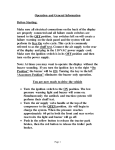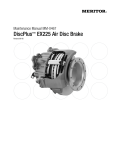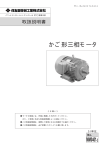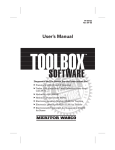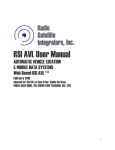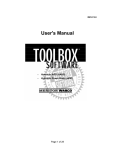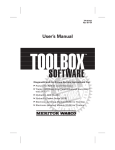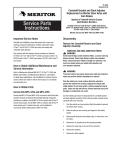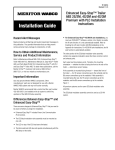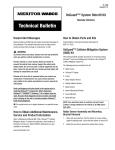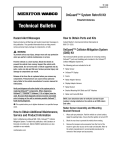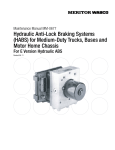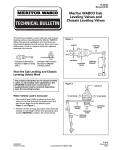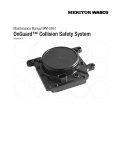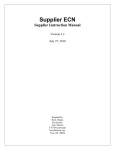Download TP-0673 - Meritor WABCO
Transcript
TP-0673 Issued 08-06 Hydraulic Compact Unit (HCU) Pump Replacement Procedure Issued 1TP-0673 Technical 08-06 Bulletin Technical Bulletin Hazard Alert Messages System Bleed Requirements Read and observe all Warning and Caution hazard alert messages in this publication. They provide information that can help prevent serious personal injury, damage to components, or both. If you are replacing the front or rear pump — and the lower reservoir is not completely drained during the procedure — it is not necessary to bleed the system. If the reservoir is drained during the procedure, you must bleed the system. How to Obtain Additional Maintenance and Service Information Refer to Maintenance Manual MM-0401, Meritor WABCO Hydraulic Power Brake (HPB) System. To obtain this publication, call ArvinMeritor’s Customer Service Center at 800-535-5560. Meritor WABCO publications are also available on our website: If you are replacing the relay valve as well as the pump(s), you must bleed the system after completing the replacement. Meritor WABCO recommends using TOOLBOX™ Software to perform the bleed. Refer to Meritor WABCO Maintenance Manual MM0401 or Technical Bulletin TP-0672, HPB Relay Valve Replacement Procedure, for complete bleed procedures. www.meritorwabco.com Before Performing Service Procedures For OnTrac dealer support, call 1-866-ONTRAC-1 (668-7221). Before working on the HPB braking system, you must depressurize the system. Depressurization instructions are outlined under Step 4 of Removal on page 2 of this bulletin. HCU Pump Replacement Procedures This publication provides instructions for the removal and installation of the HCU pump(s). Please read these instructions completely before attempting to service the system and carefully follow all outlined procedures. If you are reusing the existing relay valve and are replacing the front pump, it is not necessary to remove the master cylinder brake lines in order to access the pump plug on the bottom of the hydraulic compact unit (HCU). If you are replacing both the front and rear pumps, install the first pump before removing the second pump. Required Equipment 앫 Denatured alcohol 앫 Lint-free tissues or rags 앫 Torque wrench, clicker-type capable of 69 ± 3.54 in-lb (7.8 ± 0.4 N폷m) 앫 Torque wrench, clicker-type capable of 194.7 ± 17.7 in-lb (22 ± 2 N폷m) 앫 4 mm hex-head socket 앫 6 mm hex-head socket 앫 Drive ratchet 앫 Needle nose pliers 앫 Hose clamp pliers for ¾-inch (19.5 mm) rubber hose WARNING To prevent serious eye injury, always wear safe eye protection when you perform vehicle maintenance or service. Park the vehicle on a level surface. Block the wheels to prevent the vehicle from moving. Support the vehicle with safety stands. Do not work under a vehicle supported only by jacks. Jacks can slip and fall over. Serious personal injury and damage to components can result. To avoid serious personal injury, release all pressure from the system before you remove any components. Failure to depressurize the system may result in serious personal injury. The full power brake system is a pressurized system that achieves pressures up to 2320 psi (160 bar). This pressure is not reduced by switching the ignition off or removing battery power. Prior to servicing this system, the depressurization procedures must be performed exactly as presented. Failure to depressurize the system may result in personal injury or death. 7. CAUTION The HPB system is a complex device that provides optimum efficiency and operation. If the system sustains damage, or a component malfunctions and requires replacement, the replacement procedures provided by Meritor WABCO must be followed exactly with the associated steps performed in the order presented. Use hose clamp pliers to clamp the rubber hose at least three-inches (76.2 mm) away from the entrance to the HCU reservoir. Use care to avoid damage to the plastic reservoir nipple inside the hose. Figure 1. Figure 1 Hydraulic brake fluid is a caustic substance. Contact with the hydraulic brake fluid can cause skin irritation. Do not let hydraulic brake fluid touch any painted surfaces, as it will remove the paint. Hydraulic brake fluid may also damage certain non-metal surfaces. Do not let fluid contact brake pads, shoes, rotors or discs. Before disposing of used components, verify the warranty status. Contact OnTrac at 866-668-7221 for instructions. 4006216a Figure 1 Removal NOTE: Avoid bending or kinking the brake lines while disconnecting and handling other components. Before removing the pump, ensure the replacement pump is readily accessible. 1. Wear safe eye protection. 2. Park the vehicle on a level surface. Block the wheels to prevent the vehicle from moving. 3. Disconnect the battery. 4. Apply the brake pedal a minimum of 30 times to decrease pressure in the system. To ensure the system is depressurized, perform the following check on both the front and rear axles. A. Remove the protective cover from the end of the bleeder fitting on one brake caliper. B. Attach a bleeder bottle hose to the bleeder fitting at the wheel end. Submerge the free end of the bleeder hose into the bleeder bottle. Both the tubing and container must be able to withstand the chemical effects of hydraulic brake fluid. C. Use a wrench to open the bleeder fitting screw. D. Apply and hold the brake pedal down until no more brake fluid runs out. Do not release the brake pedal. E. With the brake pedal still applied, use a torque wrench to close the bleeder fitting screw. 5. Use a torque wrench to tighten the bleeder fitting screw to 34.7-39 in-lb (4-4.5 N폷m). @ 6. Repeat Step 4 and Step 5 for the other axle. 8. For a rear pump, proceed to Step 9. For a front pump, carefully remove the relay valve from the HCU to gain access to the pump. Do not kink or bend the brake lines while removing the relay valve. 9. Prepare the replacement pump. Lubricate both pump O-rings with brake fluid. Actuate the pump several times by depressing the spring-loaded pump button by hand. The initial force required to actuate the pump and depress the pump button may be high at first. However, after the first actuation, the force should be reduced. 10. Use a 6 mm hex-head socket wrench to remove the pump retaining plug from the HCU cavity. To minimize fluid spill, keep the replacement pump within reach and prepared for installation. Figure 2. Figure 2 4006203a Figure 2 TP-0673 Issued 08-06 Page 2 Copyright ArvinMeritor, Inc., 2006 (16579/22882) Printed in USA 2. CAUTION Use care when removing the pump to prevent damage to the O-rings. Insert the pump retaining plug into the threaded hole. Use a 6 mm hex-head socket wrench to tighten the plug to 195 ± 18 in-lb (22 ± 2 N폷m). Figure 5. @ Figure 5 11. Use needle nose pliers with a good grip to remove the pump from the bore. Use care to prevent damage to the O-rings. Avoid sliding the needle nose pliers on the pump. This can produce metal filings or contaminants which can enter the pump bore. Do not leave any foreign material in the pump bore. Figure 3. Figure 3 4006206a Figure 5 3. Repeat the procedure for removing and installing the second pump (if replacing both pumps). 4. If the front axle pump was replaced, install the relay valve. Refer to TP-0672, Hydraulic Compact Unit (HCU) Pump Relay Valve Replacement, for the correct procedures. 5. Remove the hose clamp from the rubber hose. 6. Install a bleeder adapter cap, and apply pressure to the master cylinder reservoir. Use filtered and regulated air and regulate the air to 35 psi (2.4 bar). The fluid level may drop significantly after applying pressure as the lower reservoir fills. If this occurs, pressure must be removed and fluid must be added to the MAX level. 4006204a Figure 3 12. Inspect the bore holes to verify that no foreign material such as rubber, rag lint or metal filings have entered the bore holes. If necessary, remove foreign material with a lint-free swab. 13. Install the replacement pump. Refer to the installation procedure. If you are replacing both pumps, do not remove the second pump before installing the first replacement pump. The following steps require TOOLBOX™ Software. Refer to the TOOLBOX™ User’s Manual, TP-99102, for complete operating instructions. A copy of this manual is available on the web, meritorwabco.com. Installation CAUTION Use care when installing the pump to prevent damage to the O-rings. 1. Use light hand pressure to slowly seat the pump into the bore. Use care not to damage the O-rings. Figure 4. Figure 4 4006205a Figure 4 (16579/22882) Printed in USA Copyright ArvinMeritor, Inc., 2006 TP-0673 Issued 08-06 Page 3 7. With pressure on the master cylinder reservoir, reconnect the batteries. After reconnecting the batteries, turn the ignition on. Connect TOOLBOX™ Software to the vehicle. Use this software to verify pressure is building correctly. Figure 6. Figure 8 Figure 6 Figure 8 1222 1438 4006207a 10. Use TOOLBOX™ Software to verify correct system function. Check for the following: 앫 System Pressure (Main Screen) 앫 System Faults (Fault Information Screen) Figure 6 8. Remove pressure from the master cylinder reservoir and remove the adapter cap. 9. After the accumulators have fully charged, approximately 2100 psi (145 bar), deplete the system pressure. Under the EOL menu on the HPB screen, select Deplete Accumulators. Figure 7 and Figure 8. 11. Record, then repair, any new fault occurrences. Clear the system faults. Figure 7 4006208a Figure 7 Meritor WABCO Vehicle Control Systems 2135 West Maple Road Troy, MI 48084-7121 USA 800-535-5560 meritorwabco.com Information contained in this publication was in effect at the time the publication was approved for printing and is subject to change without notice or liability. Meritor WABCO reserves the right to revise the information presented or to discontinue the production of parts described at any time. Copyright 2006 ArvinMeritor, Inc. All Rights Reserved Printed in USA TP-0673 Issued 08-06 (16579/22882)




